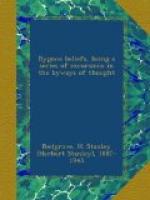[2] See CUVIER’S The Animal Kingdom, GRIFFITH’S trans., vol. viii. (1829), p. 23.
There are some curious Jewish legends to account for the supposed immortality of the phoenix. According to one, it was the sole animal that refused to eat of the forbidden tree when tempted by EVE. According to another, its immortality was conferred on it by NOAH because of its considerate behaviour in the Ark, the phoenix not clamouring for food like the other animals.[1]
[1] The existence of such fables as these shows how grossly the real meanings of the Sacred Writings have been misunderstood.
There is a celebrated bird in Chinese tradition, the Fung Hwang, which some sinologues identify with the phoenix of the West.[2] According to a commentator on the ’Rh Ya, this “felicitous and perfect bird has a cock’s head, a snake’s neck, a swallow’s beak, a tortoise’s back, is of five different colours and more than six feet high.”
[2] Mr CHAS. GOULD, B.A., to whose book Mythical Monsters (1886) I am very largely indebted for my account of this bird, and from which I have culled extracts from the Chinese, is not of this opinion. Certainly the fact that we read of Fung Hwangs in the plural, whilst tradition asserts that there is only one phoenix, seems to point to a difference in origin.
Another account (that in the Lun Yu Tseh Shwai Shing) tells us that “its head resembles heaven, its eye the sun, its back the moon, its wings the wind, its foot the ground, and its tail the woof.” Furthermore, “its mouth contains commands, its heart is conformable to regulations, its ear is thoroughly acute in hearing, its tongue utters sincerity, its colour is luminous, its comb resembles uprightness, its spur is sharp and curved, its voice is sonorous, and its belly is the treasure of literature.” Like the dragon, tortoise, and unicorn, it was considered to be a spiritual creature; but, unlike the Western phoenix, more than one Fung Hwang was, as I have pointed out, believed to exist. The birds were not always to be seen, but, according to Chinese records, they made their appearance during the reigns of certain sovereigns. The Fung Hwang is regarded by the Chinese as an omen of great happiness and prosperity, and its likeness is embroidered on the robes of empresses to ensure success. Probably, if the bird is not to be regarded as purely mythological and symbolic in origin, we have in the stories of it no more than exaggerated accounts of some species of pheasant. Japanese literature contains similar stories.




